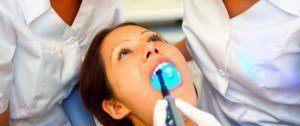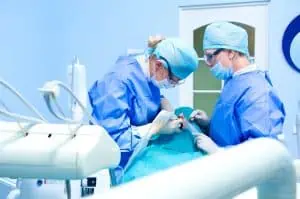Laser dentistry is any type of dental service or procedure that uses lasers instead of traditional treatment methods. There are many benefits to using lasers, including more focused treatment, less invasive procedures, the elimination of bacteria, and pain reduction.
Lasers can be used in various dental procedures including gum surgery, whitening, cleaning, root canals, and more. Continue reading to find out if laser dentistry is the best option for your dental treatment needs.
What is laser dentistry?
Just as the name suggests, laser dentistry uses lasers in treatment. This treatment started to become popular in the 1990s, so it’s still a relatively new technology. It can be used during procedures that address the teeth, including decay removal, as well as soft tissue like the gums.
The extremely narrow beam of the laser light can produce more accurate results, speed up procedures, and reduce pain.
How do dental lasers work?
Dental lasers allow light to travel through fiberoptic cables to reach the targeted tissue, whether that be the gums or teeth. The process is highly automated and tailored to each procedure.
The procedure produces microexplosions, which are cooled down so the patient suffers no heat damage.
Different laser dentistry treatments
There are a variety of applications for using lasers in dentistry. Let’s have a look at some of the most common now.


Laser teeth whitening
Laser teeth whitening combines the use of teeth bleaching gel and lasers that activate the gel. The gel absorbs the wavelength generated by the laser, which results in less sensitivity than you might get in more traditional teeth whitening methods.
The actual results are more or less the same as other professional whitening methods, but the procedure tends to be more comfortable.
Laser gum surgery
Gum surgery is the main reason for the use of dental lasers in periodontal therapy, particularly because lasers help to reduce the bacteria that cause gum disease.
You might also get laser gum surgery after you have scaling or root planing treatment. Additionally, laser gum surgery may be recommended instead of gum flap surgery. It can also be used for cosmetic reasons, like gum contouring or fixing a gummy smile.
Laser tooth cleaning
Lasers can be used instead of traditional dental tools to gently remove plaque and tartar buildup. The light energy from the laser breaks up the plaque and tartar and the experience is generally much more comfortable and even more effective than traditional tooth cleaning.
How much does laser cleaning teeth cost?
Regular dental deep cleanings cost from around $150 to $350 without insurance, and with dental lasers, it will cost a bit more because the technology is more advanced and more training is needed. However, if you do have dental insurance, there’s a good chance that laser tooth cleaning is covered, although make sure to check before you commit.
Root canals
One of the problems with traditional root canals is the difficulty of removing all of the bacteria. When bacteria are left behind, the long-term success of the treatment is jeopardized.
Root canal treatment performed with dental lasers can improve treatment results substantially. The antimicrobial benefits of lasers help to eliminate microorganisms that chemicals used in traditional methods are unable to eliminate.
Laser dentistry for cavities
Dental lasers are able to remove very precise spots of decayed tissue, resulting in less invasive treatment and a greater amount of healthy tooth saved. Have a look at a summary of the benefits of using dental lasers for cavity removal:
- Selective and precise removal of decay
- Noiseless and no vibrations from drills
- There is often no need for anesthesia
- Cavities are left cleaner because of the lasers’ antibacterial properties
There are also some disadvantages of using lasers in cavity removal:
- Lasers should not be used to remove amalgam fillings or ceramic restorations — for this, a drill must still be used
- Not all decay can be managed by lasers, depending on the location of the cavity
- Lasers are really only meant to be used with resin composite filling material
Oral surgery


The most common type of oral surgery that uses lasers is laser gum surgery, which especially benefits due to the laser’s ability to delicately manage soft tissue, reduce bacteria, control bleeding, and eliminate pain and postoperative sensitivity.
But there are other oral surgeries that can be performed and improved with the use of dental lasers. Have a look at some of the most common:
- Crown enlargement
- Gingivectomy (gum tissue removal)
- Frenectomy (a problem that can cause tongue tie)
- Removal of dark spots
- Ulectomy (used to remove gum tissue from an unerupted tooth)
- Biopsies
Lasers are beneficial in these procedures because they reduce the need for flaps and sutures.
Orthodontics
Low-level laser therapy can accelerate metabolic changes and so is effective in bone regeneration and tooth movement after procedures to expand the upper palate.
However, there is some controversy surrounding the claim that low-level laser therapy has pain-relieving effects during orthodontic treatment.
Benefits of laser dentistry
There are various benefits and advantages for dental lasers, including:
Diagnostics
Argon and diode lasers are useful in the detection of caries through a process called fluorescence. This process takes place when specific molecules are excited by the interaction with electromagnetic waves, and as a result, they emit light.
In other words, fluorescence allows dentists to detect cavities and decay, even when they aren’t visible to the human eye.
Antimicrobial benefits
Dental lasers have antibacterial properties and can help manage viruses, bacterial infections, and fungal infections. That’s because of a specific wavelength of light that, when combined with a photosensitizer and oxygen, kills bacteria.
If a patient has a viral or fungal infection, laser therapy may help prevent the formation of painful lesions when used early on. They can also speed up the healing process and decrease the likelihood of a repeat occurrence.
In surgical and nonsurgical procedures, dental lasers can disinfect the targeted tissue through cauterization, contributing to preventing postoperative contamination. Or, in the case of removing decay, dental lasers make sure that the tooth is sterile before applying a filling. This helps contribute to long-term restoration.
There are also some studies that suggest that laser gum surgery can help patients who have immune deficiencies.
Pain relief
Dental lasers can be used to reduce acute pain before and after invasive procedures, such as tooth removal. They can also be used to reduce tooth sensitivity.
When lasers are applied before an anesthetic injection, they can produce a primary numbing effect. After an invasive procedure, dental lasers contribute to significantly reducing postoperative pain.
Anti-inflammatory
This is a bit controversial in the dental community, but some recent studies suggest that low-level laser therapy, when combined with active exercise, can compete with drug treatments in response to conditions such as active myofascial trigger points.
In the video below you can watch Dr. Bedich describe the various benefits and uses of lasers in dentistry.
Is laser dentistry safe?
There aren’t many risks associated with laser dentistry. That being said, it’s critical to find a dental professional who is qualified and trained in the use of lasers.
When used at the wrong wavelength, lasers could damage oral tissue. It’s also necessary to wear special goggles during treatment to protect your eyes.
Types of lasers used
It goes without saying that you can’t just use any laser for laser dentistry. In fact, each different oral tissue will require a specific type of laser. If you are really curious, you can have a look at the table below which summarizes the types of lasers used:
Common dental lasers | |
Hard lasers | Soft lasers |
|
|
Due to the wavelength of power diode-based lasers, they could be classified as high-power lasers but because of their applications in dentistry they are also grouped with lower-level laser therapies.
Hard lasers create high energy levels and are used to cut and vaporize tissues or remove tumors. Soft lasers can decrease inflammation and relieve pain in oral tissues. They can also be used to manage infections.
Laser dentistry costs
Laser dentistry is generally more expensive than traditional treatment methods. Costs will vary depending on the procedure and where you live. Have a look at the table below to get a feel for general laser dentistry costs:
Treatment | Cost (US) |
Gum disease treatment | $1,000 – $2,700 |
Laser fillings | $300 – $500 |
Laser teeth whitening | $600 – $800 |
Conclusion
Dental lasers can be used for a variety of dental treatments, including gum surgery, endodontic treatment, teeth whitening, and deep teeth cleaning. Because of the advanced technology, it is generally more expensive than traditional procedures. However, the added comfort to the patient and the better results make it worth it for many people.
You can ask your dentist if dental lasers are a possibility the next time you need a treatment.
FAQs
Does dental laser therapy hurt?
Overall, laser dental therapy is a painless experience. However, there are some procedures that may still require anesthetic injections beforehand, such as oral surgery.
Is laser dentistry dangerous?
Laser dentistry can be dangerous if not performed correctly and with the correct eye protection. Lasers damage eyes, so it’s essential your dentist gives you the proper protection.
Pubmed: Lasers: A Review With Their Applications in Oral Medicine. Consulted 4th January 2022.
Pubmed: Laser in dentistry: An innovative tool in modern dental practice. Consulted 4th January 2022.
Pubmed: Non carious cervical lesions. A review. Consulted 4th January 2022.
Pubmed: Lasers and soft tissue: ‘loose’ soft tissue surgery. Consulted 4th January 2022.
Pubmed: Antimicrobial photodynamic therapy combined with conventional endodontic treatment to eliminate root canal biofilm infection. Consulted 4th January 2022.
Dantas CMG, Vivan CL. Temporomandibular disorders. Lasers in Dentistry2015. Consulted 4th January 2022.
Sperandio FF, Sabino CP, Vecchio D, Garcia-Diaz M, Huang L, Huang Y-Y, et al. Antimicrobial photodynamic therapy in dentistry. Lasers in Dentistry2015. Consulte 4th January 2022.
Theodoro LH, Garcia VG. Surgical and non-surgical treatment of periodontal diseases. Lasers in Dentistry, 2015. Consulted 4th January 2022.
Zanin F, Brugnera Jr A, Windlin MC. Dental bleaching with LEDs and lasers. Lasers in Dentistry, 2015. Consulted 4th January 2022.
Zezell DM, Ana PA. High power lasers and their interaction with biological tissues. Lasers in Dentistry, 2015. Consulted 4th January 2022.
Bjordal JM, Lopes-Martins RAB, Frigo L. Low level laser therapy – mechanism of action. Lasers in Dentistry, 2015. Consulted 4th January 2022.
Braga MM, Gimenez T, Mendes FM, Deery C, Ricketts DNJ. Caries diagnosis. Lasers in Dentistry, 2015. Consulted 4th January 2022.
Chow R. Low level laser therapy – mechanism of action. Lasers in Dentistry, 2015. Consulted 4th January 2022.




